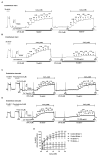Vasorelaxant Effect of Trachelospermi caulis Extract on Rat Mesenteric Resistance Arteries
- PMID: 36014534
- PMCID: PMC9413539
- DOI: 10.3390/molecules27165300
Vasorelaxant Effect of Trachelospermi caulis Extract on Rat Mesenteric Resistance Arteries
Abstract
Background: Trachelospermi caulis (T. caulis) has been used as a traditional herbal medicine in Asian countries. Although it is well known that T. caulis has beneficial effects, no sufficient research data are available on the cardiovascular effect of T. caulis. We investigated whether T. caulis extract has vascular effects in rat resistance arteries in this study.
Methods: To examine whether T. caulis extract affects vascular reactivity, we measured isometric tension of rat mesenteric resistance arteries using a multi-wire myograph system. T. caulis extract was administered after arteries were pre-contracted with high K+ (70 mM) or phenylephrine (5 µM). Vanillin, a single active component of T. caulis, was used to treat mesenteric arteries.
Results: T. caulis extract caused vascular relaxation in a concentration-dependent manner, which was endothelium-independent. To further identify the mechanism, we incubated the arteries in Ca2+-free solution containing high K+, followed by a cumulative administration of CaCl2 (0.01-2.0 mM) with or without T. caulis extract (250 µg/mL). The treatment of T. caulis extract decreased contractile responses induced by the addition of Ca2+, which suggested that the extracellular Ca2+ influx was inhibited by the T. caulis extract. Moreover, an active compound of T. caulis extract, vanillin, also induced vasodilation in mesenteric resistance arteries.
Conclusion: T. caulis extract and its active compound, vanillin, concentration-dependently induced vascular relaxation in mesenteric resistance arteries. These results suggest that the administration of T. caulis extract could help decrease blood pressure.
Keywords: Ca2+; Trachelospermi caulis; mesenteric resistance arteries; relaxation; vanillin; vasodilation.
Conflict of interest statement
The authors declare no conflict no interest.
Figures







Similar articles
-
Vanillin Induces Relaxation in Rat Mesenteric Resistance Arteries by Inhibiting Extracellular Ca2+ Influx.Molecules. 2022 Dec 29;28(1):288. doi: 10.3390/molecules28010288. Molecules. 2022. PMID: 36615485 Free PMC article.
-
Vasodilatory Effect of Alpinia officinarum Extract in Rat Mesenteric Arteries.Molecules. 2022 Apr 22;27(9):2711. doi: 10.3390/molecules27092711. Molecules. 2022. PMID: 35566064 Free PMC article.
-
Vasodilatory Effect of Phellinus linteus Extract in Rat Mesenteric Arteries.Molecules. 2020 Jul 10;25(14):3160. doi: 10.3390/molecules25143160. Molecules. 2020. PMID: 32664327 Free PMC article.
-
The Curcumin-Induced Vasorelaxation in Rat Superior Mesenteric Arteries.Ann Vasc Surg. 2018 Apr;48:233-240. doi: 10.1016/j.avsg.2017.09.007. Epub 2017 Sep 22. Ann Vasc Surg. 2018. PMID: 28943490
-
[Mechanisms underlying enhanced vasodilator responses to various vasodilator agents following endothelium removal in rat mesenteric resistance arteries].Yakugaku Zasshi. 2007 Apr;127(4):729-33. doi: 10.1248/yakushi.127.729. Yakugaku Zasshi. 2007. PMID: 17409704 Review. Japanese.
Cited by
-
Vanillin Induces Relaxation in Rat Mesenteric Resistance Arteries by Inhibiting Extracellular Ca2+ Influx.Molecules. 2022 Dec 29;28(1):288. doi: 10.3390/molecules28010288. Molecules. 2022. PMID: 36615485 Free PMC article.
References
-
- Virani S.S., Alonso A., Benjamin E.J., Bittencourt M.S., Callaway C.W., Carson A.P., Chamberlain A.M., Chang A.R., Cheng S., Delling F.N., et al. Heart disease and stroke statistics-2020 update: A report from the american heart association. Circulation. 2020;141:e139–e596. doi: 10.1161/CIR.0000000000000757. - DOI - PubMed
MeSH terms
Substances
Grants and funding
LinkOut - more resources
Full Text Sources
Miscellaneous

